Tums, stylized as TUMS, is a popular antacid available over-the-counter at many retail stores, including grocery stores, drug stores, and supermarkets. It provides relief from indigestion, heartburn, sour stomach, etc.
Everyone, including plant-based eaters, deals with heartburn and GERD from time to time, so I get asked quite a bit if antacids, specifically Tums, are suitable for vegan consumption.
Is it vegan? The original Tums, which comes flavored as assorted fruit and mint, is generally considered vegan. It’s made of sucrose (table sugar), calcium carbonate (CaCO3), along with a few inactive ingredients like mineral oil, natural and artificial flavors, organic acids, and vegan-friendly food colorants.1
The disclaimer is that extra prudent vegans may want to stay away from foods, medicines, and supplements that contain calcium carbonate. While the compound is usually extracted from the earth, it can be derived industrially from non-vegan sources like eggshells and oyster shells.
There are several variations of the original product, and we’ll be covering the most common forms of Tums in this article.
Vegan Varieties
TUMS Regular Strength
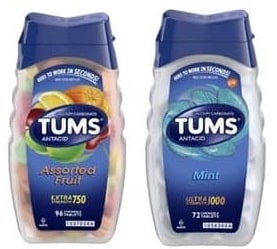
We’ll start with the standard product, as I’d imagine that most folks inquiring about Tums are referring to this product.
This one comes in assorted fruit and peppermint flavors. The main active ingredient for both is calcium carbonate, a chemical compound with the formula CaCO3.
Calcium carbonate occurs naturally in rocks and tends to be derived from stones that are primarily composed of the compound, including chalk, limestone, marble, and travertine.2
Shells in the ocean, left behind by microorganisms, are another common source.3
It is true that there are some biological sources of the compound, as it occurs naturally in eggshells, seashells, and snail shells, all of which have served as industrial sources.4
Oyster shells are a particularly common—for a biological source, anyway.5,6
So, if calcium carbonate can be derived from animal sources, then how is it that products like Tums can be considered suitable for vegans?
Well, it’s not because calcium carbonate exists in the plant kingdom. While it is found in dark green veggies like kale and broccoli, plants are not seen as a practical industrial source of the compound.7
The reason is that most in the community don’t scrutinize calcium carbonate-containing foods too heavily.
For one, the Vegetarian Resource Group (VRG) conducted a survey where they reached out to a number of food, drink, and medicine companies. They found the calcium carbonate in most products to be sourced from minerals, not oyster shells and other animal products.8
Secondly, PETA has perhaps the largest and most comprehensive list of animal-derived ingredients, and nowhere on the lists is calcium carbonate mentioned.9
Keep in mind that there’s always the possibility that the calcium carbonate derived from an animal at some point. So, again, if you’re an extra careful vegan, you may want to avoid the stuff. It’s just a matter of the level of risk you’re comfortable with.
Other Ingredients
Additional (inactive) ingredients for the assorted fruit include adipic acid, corn starch, Blue 1 Lake, Red 40 Lake, Yellows 5 and 6 (Lake), flavors, mineral oil, sucrose, sodium polyphosphate, and talc.10
Inactive ingredients for the mint include corn starch, mineral oil, flavor, sodium polyphosphate, sucrose, and talc.10
No problems here.
TUMS Sugar-Free
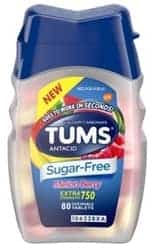
These are basically the same, but without the sugar. Specifically, the inactive ingredients include acacia gum, Red 40 Lake, Yellow 5 Lake (tartrazine), flavors, sorbitol, calcium stearate*, and sucralose.11
*Like mono- and diglycerides, stearic acid is derived from triglycerides which can be both of animal and plant origin.
This specific fatty acid is more abundant in animal fat (up to 30%) compared to vegetable fat (which is around <5%). But, there are some plant sources that contain exceptionally high levels of the FA, including cocoa and shea butters—these sources contain, on average, anywhere from 28% to 45%.12
Most vegans don’t scrutinize such ingredients too heavily. But, if you want to be extra careful, you may want to avoid products containing the additive.
TUMS Smoothies
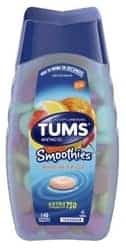
These come in assorted fruit, assorted tropical fruit, berry fusion, and peppermint flavors.
Inactive ingredients for the three flavors include various starch sources (cornstarch, dextrose, maltodextrin, etc.) adipic acid, artificial colors (Red 40 Lake in this case), flavors, vegetable gums (e.g. guar, microcrystalline cellulose), sucrose (table sugar), magnesium stearate, and sorbitol.13
Non-Vegan Varieties (Insect Byproducts, Dairy)
Keep in mind that these are considered non-vegan by major organizations like the VRG, PETA, and the Vegan Society.14,9
But, not all vegans actively avoid insect-derived products.15
TUMS Chewy Bites Cooling Sensation (Beeswax, Shellac)
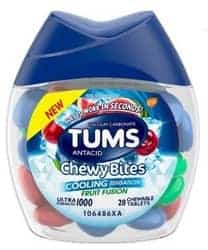
Chewy is usually a red flag because it can often mean that gelatin is used. These don’t contain gelatin, but they do contain insect-derived ingredients.
Inactive ingredients:16
- Alcohol, purified water
- Ammonium hydroxide
- Waxes: carnauba and beeswax
- Citric acid, lecithin, gum arabic
- Coconut oil, medium-chain triglycerides, soybean oil, vegetable oil
- Corn starch, sucrose, corn syrup, modified starch, maltodextrin, and dextrin
- Artificial colors, flavors
- Methylparaben, n-butyl alcohol, isopropyl alcohol, ethyl acetate, polyvinylpyrrolidone, propylene glycol, propylparaben, tert-butyl hydroquinone, titanium dioxide
- Phosphoric acid
- Shellac
- Sorbic acid, sorbitol, sodium benzoate
Most know what beeswax is, but shellac often flies under the radar. It’s a substance secreted by lac bugs as they traverse tree trunks and branches.17
The bugs actually secrete “sticklac” from which shellac is filtred out to be used in what’s known as confectioner’s glaze.
Not all vegans avoid the stuff, but it seems to be largely considered a non-vegan ingredient.
TUMS Chewy Bites with Gas Relief, Lemon and Strawberry (Beeswax, Carmine, Shellac)
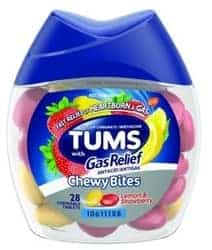
This one contains:18
- Alcohol, ammonium hydroxide
- Beeswax and carnauba wax, and shellac
- Caprylic/capric triglycerides
- Citric acid
- Coconut oil
- Corn starch, corn syrup, dextrin, maltodextrin, modified cornstarch, and sucrose
- Ethanol, ethyl acetate, ethyl alcohol, isopropyl alcohol, n-butyl alcohol
- Flavors
- Gum arabic, methylparaben, propylparaben
- Artificial colors including carmine
- Phosphoric acid, purified water
- PVP, TBHQ, titanium dioxide
- Sodium benzoate, sorbic acid, sorbitol
- Soybean oil and soy lecithin
Carmine, aka Red 4 is a common food colorant. It’s not quite as common as Red 40, but you’ll still run into it from time to time.
Unlike Red 40, which is petroleum-derived, carmine is produced from beetles.19,20
So, it’s yet another insect-derived substance.
TUMS Chewy Bites, Assorted Berry (Beeswax, Carmine, Shellac)
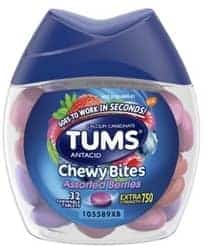
This product contains:21
- Acacia gum, gum arabic
- Alcohol, ammonium hydroxide, ethyl acetate, ethyl alcohol, isopropyl alcohol, n-butyl alcohol, propylene glycol
- Beeswax and carnauba wax, methylparaben, propylparaben, shellac
- Caprylic/capric triglycerides
- Citric acid
- Coconut oil
- Corn starch, corn syrup, dextrin, maltodextrin, modified corn starch, sucrose
- Flavors
- Phosphoric acid, PVP
- Artificial food dyes including carmine
- Purified water
- Sodium benzoate, sorbic acid, sorbitol
- Soybean oil, soy lecithin, vegetable oil
- TBHQ, titanium dioxide, triacetin
TUMS Chewy Delights (Milk)
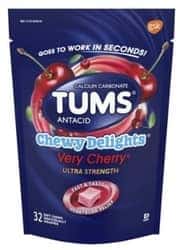
These come in three flavors—Very Cherry, Smooth Peppermint, and Orange Rush—all of which are non-vegan due to the presence of dairy products.
All three flavors contain simple carbs (corn starch, corn syrup, corn syrup solids, etc.), artificial colors, an emulsifier (e.g. glycerin, soy lecithin), sucrose, vegetable gums, various additives, and non-fat dairy milk.22
That’s it for the vegan status of Tums. Thanks for reading.
References
- (2 Pack) Tums Antacid Chewable Tablets For Heartburn Relief, Extra Strength, Assorted Fruit, 96 Tablets. ChristinA- Shelbel – https://www.walmart.com/ip/2-Pack-Tums-antacid-chewable-tablets-for-heartburn-relief-extra-strength-assorted-fruit-96-tablets/889661937
- Calcium carbonate. https://en.wikipedia.org/wiki/Calcium_carbonate#Occurrence
- How Many Tums Are in the Ocean? – Adam Subhas. Cswauthor – https://csw.unols.org/how-many-tums-are-in-the-ocean-adam-subhas/
- How Are Seashells Created? Or Any Other Shell, Such As a Snail’s or a Turtle’s?. https://www.scientificamerican.com/article/how-are-seashells-created/
- Natural Oyster Shell Calcium Oral: Uses, Side Effects, Interactions, Pictures, Warnings & Dosing. https://www.webmd.com/drugs/2/drug-16642/natural-oyster-shell-calcium-oral
- Oyster Shell Calcium Carbonate. https://web.archive.org/web/20130910033017/http://caltronclays.in/Oyster_CC.html
- Heaney, R. P.; Weaver, C. M.; Hinders, S. M.; Martin, B.; Packard, P. T. (1993). “Absorbability of Calcium from Brassica Vegetables: Broccoli, Bok Choy, and Kale”. Journal of Food Science. 58 (6): 1378–1380. https://onlinelibrary.wiley.com/doi/abs/10.1111/j.1365-2621.1993.tb06187.x
- The Vegetarian Resource Group Blog. https://www.vrg.org/blog/2011/12/12/calcium-carbonate-in-most-soy-rice-beverages-and-in-calcium-supplements-derived-from-a-mineral-source-not-oyster-shell-source-does-not-have-to-be-labeled/
- Animal-derived Ingredients Resource: Living. https://www.peta.org/living/food/animal-ingredients-list/
- Tums® Regular Strength: Tums® Antacid. https://www.tums.com/antacid-products/regular/
- Tums® Sugar-free. https://www.tums.com/antacid-products/sugar-free/
- Beare-Rogers, J.; Dieffenbacher, A.; Holm, J.V. (2001). “Lexicon of lipid nutrition (IUPAC Technical Report)”. Pure and Applied Chemistry. 73 (4): 685–744. https://www.degruyter.com/view/j/pac.2001.73.issue-4/pac200173040685/pac200173040685.xml
- Tums® Smoothies™ https://www.tums.com/antacid-products/smoothies/
- The Honey Industry. https://www.vegansociety.com/go-vegan/honey-industry
- Why Vegans Can’t Decide Whether They’re Allowed To Eat Honey. Daniel Engber – https://slate.com/human-interest/2008/07/why-vegans-can-t-decide-whether-they-re-allowed-to-eat-honey.html
- Tums® Chewy Bites® Cooling Sensation. Kari H- Mandy- Ari – https://www.tums.com/antacid-products/chewy-bites-cooling-sensation/
- Flinn, Angel. “Shellac and Food Glaze” http://gentleworld.org/shellac-food-glaze/
- Tums® Chewy Bites with Gas Relief®: Tums® Antacids. https://www.tums.com/antacid-products/chewy-bites-gas-relief/
- Bug-Based Food Dye Should Be Exterminated, Says CSPI. https://cspinet.org/news/bug-based-food-dye-should-be-exterminated-says-cspi-20060501
- Carol Potera. DIET AND NUTRITION: The Artificial Food Dye Blues. Environ Health Perspect. 2010 Oct; 118(10): A428. https://www.ncbi.nlm.nih.gov/pmc/articles/PMC2957945/
- Tums® Chewy Bites: Tums® Antacids. https://www.tums.com/antacid-products/chewy-bites/
- Tums® Chewy Delights® https://www.tums.com/antacid-products/chewy-delights/

